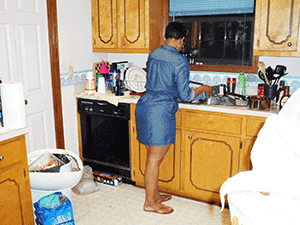There are set standards that should be observed and maintained in the kitchen. Some of them are ensuring that the kitchen is clean and the utensils are well arranged. This is termed kitchen hygiene.
Kitchen hygiene is extremely necessary, as germs that cause food poisoning are mostly transmitted from the kitchen.
The germs that can cause food poisoning are usually controlled by heating (cooking) or chilling (refrigerating) the food. But given half a chance, they can easily spread around the kitchen through the hand, chopping board, cloth, knife and other kitchen utensils.
One of the major domesticated gripes is seeing someone who is supposed to be a cook wearing his or her jewellery, or mix ingredients with bare palms, without first removing their rings.
The jewellery may be beautiful. The microscopic germs skulking on and under its surfaces could cause food poisoning.
Therefore, before cooking or baking, the following should be observed:
*Ensure that your nails are short, not polished (chips of polish can contaminate food, and colour hides dirt under nails). No nail extensions.
*Take off all jewellery, including necklaces, wristwatches and brooches, to prevent falling into food and bringing contaminants.
*Ensure there are no loose labels on clothes; that is why it is important to wear an apron to protect the food from the contaminants on your clothes.
*Consider a hair net or hair cover (even as it looks a bit odd), if you have long hair.
*Wash your hands thoroughly in the wash-hand basin, washing well between the fingers and scrubbing the nails.
*Remove plug from sink before drying your hands –preferably with a paper towel.
*Disinfect the work surfaces using the kitchen surface cleaner.
Food preparation
*In making use of a chopping board, choose the right one for the job, as most of them are usually colour coded. Choose a ‘raw’ or a ‘cooked’ knife, to avoid contamination. This means assigning a knife for raw foods and another for cooked foods.
*We should be knowledgeable about micro-organisms that cause food poisoning, the main one is bacteria.
Bacteria are living things that have only one cell. Under a microscope, they look like balls, rods, or spirals. They are so small that a line of 1,000 could fit across a pencil eraser.
Most bacteria will not hurt the body – less than one per cent of the different types of bacteria make people really sick. Many are helpful. Some bacteria help to digest food, destroy disease-causing cells, and give the body needed vitamins. Bacteria are also used in making healthy foods like yoghurt and cheese.
But infectious bacteria can make one really ill; they reproduce quickly in the body. Many give off chemicals called toxins, which can damage body tissues. Examples of bacteria that cause infections are streptococcus, staphylococcus, and e.coli.
Bacteria can be killed by thoroughly cooking the meal.
There are some foods that are considered as high risk in terms of contamination. Examples are meat products, including milk, cream, artificial cream, custards and dairy; cooked eggs and products made from eggs like mayonnaise; shellfish and other seafood etc. Bacteria multiply with warmth, moisture and can multiply every 10 minutes and grow in the danger zone. Therefore, foods that are high risks should be stored in the refrigerator at the required temperature
*When handling these high risk foods, clean kitchen surfaces after every stage and always wash your hands and utensils before touching anything else.
*After cooking, it is preferable to wash all your dishes and utensils with hot water and dish-washing liquid.











